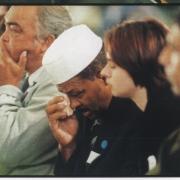Sustaining Peace: Reintegrating Former Combatants into Society
Summary Available
In many conflicts, the line between sufferer and perpetrator is often blurred. In the aftermath of violence, the time comes for survivors, soldiers and innocents alike, to return home and heal collectively. This process gives rise to many problems—ex-combatants face stigmas and mental health problems, a lack of employable skills or education, and an absence of community ties. Meanwhile, non-combatants deal with their own traumas, the realities of living in a war torn society, and anger towards military groups. The reintroduction of former soldiers into society at large is crucial to building lasting peace and stability because without it many ex-combatants, devoid of ties to community or resources for self-sufficiency, would return to their guerrilla groups or armies. However, Disarmament, Demobilization, and Reintegration (DDR) programs must overcome many barriers to succeed. In this conversation, experts discuss the challenges and tactics of achieving effective reintegration of ex-combatants into society.


 The South African Truth and Reconciliation Commission (TRC) developed the concept of “briefers” to install a victim-friendly process. Victims were provided with the opportunity to testify and be supported before, during and after the process. The TRC selected briefers—chosen from the caring professions, such as ministers, social workers and nurses—from the community to provide this support. The briefers acted as volunteers and were trained to perform various tasks with regard to the entire structural process of the TRC.
The South African Truth and Reconciliation Commission (TRC) developed the concept of “briefers” to install a victim-friendly process. Victims were provided with the opportunity to testify and be supported before, during and after the process. The TRC selected briefers—chosen from the caring professions, such as ministers, social workers and nurses—from the community to provide this support. The briefers acted as volunteers and were trained to perform various tasks with regard to the entire structural process of the TRC. 